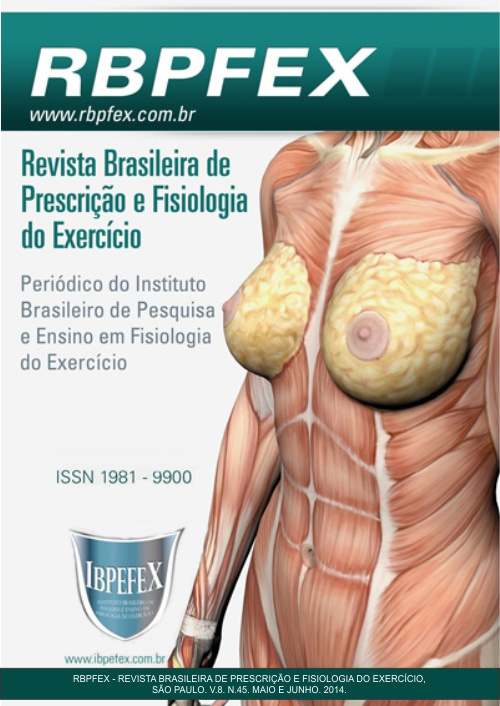The influence of one RPM cycling training session blood pressure in women
Abstract
The present study aimed to evaluate the influence of a training session RPM cycling the levels of systolic and diastolic in women. The study sample consisted of 18 women aged 20 to 30 years. Methodological strategy evaluation study was decided to use a blood pressure measurement of women at two points before the start of the intervention period and developed after an assessment. As an intervention strategy was held practice session RPM cycling. Through statistical analysis of the participants in both groups showed significant scores, where both the systolic and diastolic exhibited reduced by the proposed intervention identifying and confirming the importance of such training. Therefore it can be stated that the method of training the RPM cycling is effective in reducing levels of systolic and diastolic women, and can be used as an intervention in the prevention and control of arterial hypertension due to its numerous benefits organic system.
References
-Benish, M.; Zeitlin, I.; Deshet, D.; Beigel, Y. Massive Indoor Cycling-induced Rhabdomyolysus in a Patient with hereditary neuropathy with liability to pressure palsy. Israel Medical Association Journal. Vol. 14. Núm. 11. p. 712-714. 2012.
-Bianco, A.; e colaboradores. The effects of indoor cycling training in sedentary overweight women. Journal Sports Medical physical fitness. Vol. 50. Núm. 2. p. 159-165. 2010.
-Brasil.Ministério da Saúde. Resolução 196/96 do Conselho Nacional de Saúde/MS Sobre Diretrizes e Normas Regulamentadoras de Pesquisa envolvendo seres humanos. Diário Oficial da União, 10 de outubro. 1996.
-Botelho, L. P.; Vale, R. G. S.; Senna, G.W.; Lucidi, M. A.; Nunes, R. A.M.; Dantas, E. H. M. Pressão arterial de mulheres praticantes de ginástica funcional. HU revista. Vol. 37. Núm. 3. p. 339-346. 2012.
-Body Systems. RPM cycling. Apostila do curso de RPM. Les Millis International Limitend. 2010.
-Polito, M. D.; Farinatti, P. T. V. Comportamento da pressão arterial após exercícios contra-resistência: uma revisão sistemática sobre variáveis determinantes e possíveis mecanismos. Revista Brasileira de Medicina do Esporte. Vol. 12. Núm. 6. p. 386-392. 2006.
-Jones, H.; e colaboradores. The acute post-exercise response of blood pressure varies with time of day. European Journal ofApplied Physiology. Vol. 104. p. 481-489. 2008.
-Lythe, J.;Pfitzinger, P. Caloric expenditure and aerobic demand of BODY STEPTM, RPMTM, BODY COMBATTM and BODY ATTACKTM. Unisports Centrefor sport performance: Auckland. p. 1-15. 2000.
-Medina,L. F.; Lobo, S. F.; Souza, R. D.; Kanegusuku, H.; Forjaz, M. L. C. Atividade física: impacto sobre a pressão arterial. Revista Brasileira de Hipertensão. Vol. 17. Núm. 2. p. 103-106. 2010.
-Millar, P. J.; e colaboradores. The hypotensive effects of isometric handgrip training using an inexpensive spring handgrip training device. Journal of Cardiopulmonary Rehabilitation and Prevention, Ontario. Vol. 28. p. 203-207. 2008.
-Pattyn, N.; Cornelissen, V. A.; Eshghi, S. R. T.; Vanhees, L. The effect of exercise on the cardiovascular risk factors constituting the metabolic syndrome. Sports Medicine. Vol. 43. p. 121-133. 2013.
-Thomas, J. R.; Nelson, J. K.; Silverman, S. J. Métodos de pesquisa em atividade física. 6ª edição. Porto Alegre. Artmed. 2012.
Authors who publish in this journal agree to the following terms:
- Authors retain the copyright and grant the journal the right of first publication, with work simultaneously licensed under the Creative Commons Attribution License BY-NC which allows the sharing of the work with acknowledgment of the authorship of the work and initial publication in this journal.
- Authors are authorized to enter into additional contracts separately for non-exclusive distribution of the version of the work published in this journal (eg, publishing in institutional repository or book chapter), with acknowledgment of authorship and initial publication in this journal.
- Authors are allowed and encouraged to post and distribute their work online (eg, in institutional repositories or on their personal page) at any point before or during the editorial process, as this can bring about productive change as well as increase impact and impact. citation of published work (See The Effect of Free Access).






